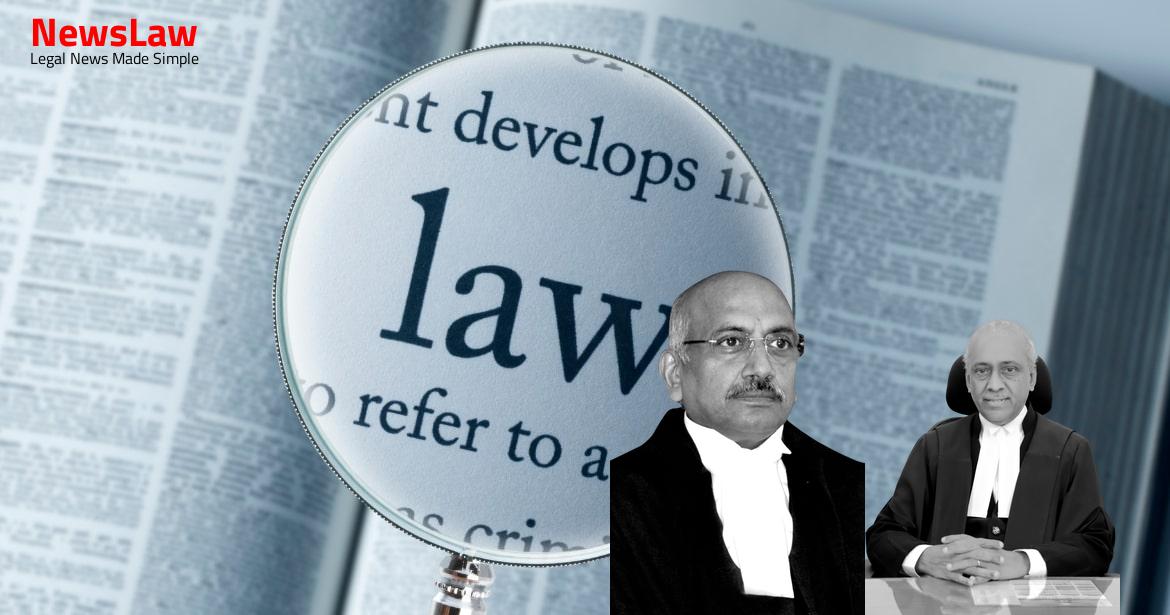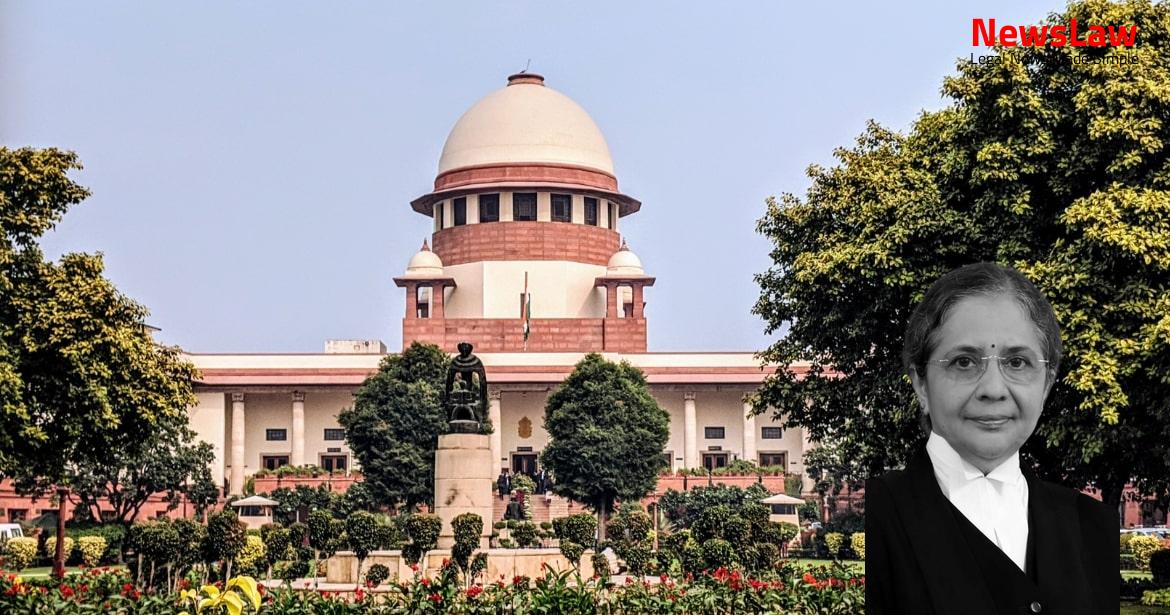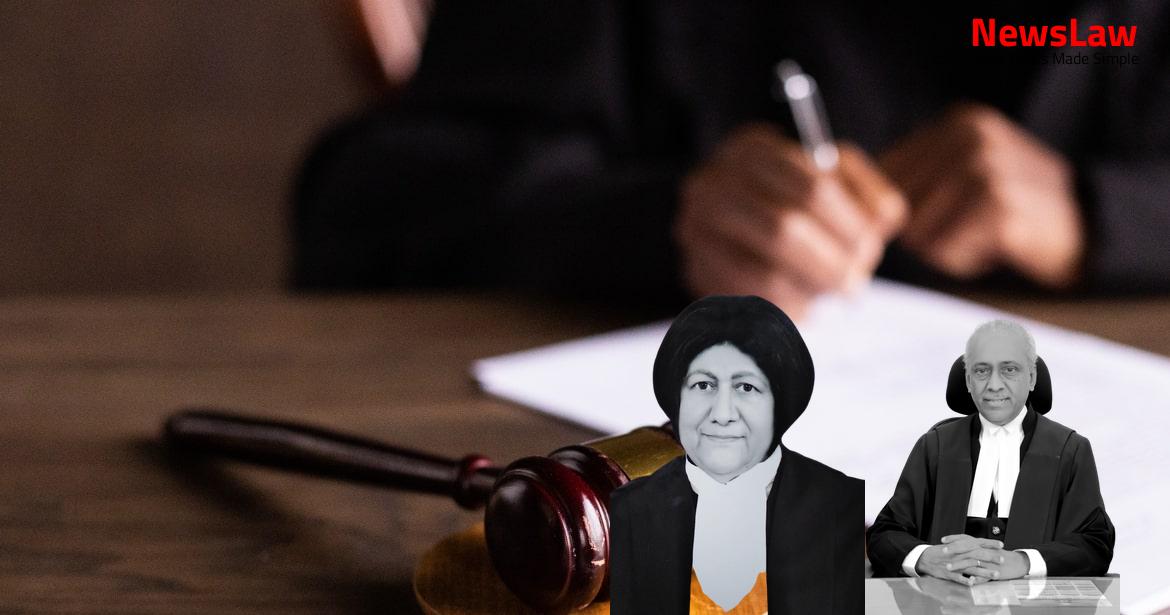Delve into a thorough examination of the court’s legal analysis regarding the surrender of tenancy rights. The focus is on the intricate details of statutory provisions and the proper process that must be followed in such cases. This summary sheds light on the importance of adhering to legal protocols and the implications of not doing so.
Facts
- The protected tenant surrendered tenancy rights orally in favor of Shri Thota Balakrishna Reddy in 1954.
- Ownership rights were conferred on the protected tenant on 20.3.1975 under Section 38-E of the Tenancy Act.
- The purchaser claimed occupancy rights on 19.2.1982, which were later annulled by the High Court’s order on 3.6.2019.
- The purchaser seeks restoration of occupancy rights granted in their favor on 19.2.1982.
- The purchaser obtained tenancy rights through oral surrender in 1954 and a registered document on 5.7.1957.
- An order was passed by the Mandal Revenue Officer on 31.1.1989 recognizing the surrender of tenancy rights by the protected tenant.
- The protected tenant withdrew an appeal against the grant of occupancy rights to the purchaser on 14.2.1989.
- The purchaser received an occupancy rights certificate in 1975 under the Inams Act.
Also Read: Interpretation of Will and Hindu Succession Act: Legal Analysis
Arguments
- Inams Act recognizes the right of Inamdar and protected tenant to sell/alienate their rights in the land.
- Section 30 restricting sub-division, sub-letting, and alienation under Tenancy Act is argued not to be applicable due to the Inams Act.
- Arguments based on affidavits admitting sale of land in 1957 and issuance of occupancy right in 1982 after due enquiry.
- Compromise in judicial proceedings in 1989 led to withdrawal of appeal against grant of occupancy rights certificate.
- Delay of 36 years deemed to bar later appeal against the grant of occupancy rights.
- Possession since purchase date asserted to have perfected into title under the law.
- Protected tenant’s claim in 2015 after 33 years deemed unreasonable and defeated by delay.
- The purchasers had bought Inam land governed by the Inams Act.
- Suppression of relevant facts by Respondent Nos. 3 to 10 noted, with reference to legal precedents on the need for timely action.
- Challenges to the grant of occupancy certificate after a significant delay criticized, citing legal precedents on reasonable time for dispute.
- Respondents argued that the objection of the purchaser was related to settlement and withdrawal of appeal by protected tenants in 1989 and delay in filing appeal in 2015.
- The Tenancy Act and Inams Act aim to protect the rights of tenants and prevent them from relinquishing their rights.
- Protected tenants can only surrender their rights with permission from the Competent Authority, oral surrender or sale is prohibited.
- The purchasers did not disclose the appeal filed with Joint Collector or High Court which affects final vesting.
- Interpretation of statutes should protect tenants from exploitation by landowners.
- Legal procedure for surrender of tenancy rights must be followed as prescribed by the statute.
- Predecessor-in-interest of the purchaser had occupancy rights under Inams Act as per possession on 01.11.1973.
- The High Court relied on wrong judgment, and some previous court cases are cited to support appellants’ arguments.
Also Read: Analysis of High Court’s Decision on Registration Certificate and Onus of Proof in Sales Tax Case
Analysis
- Section 38-E of the Tenancy Act, inserted in 1971, grants ownership rights to protected tenants.
- Ownership certificate under Section 38-E overrides any other law, including the Inams Act.
- Protected tenants have the right to seek possession even if not in physical possession of the land.
- The surrender of tenancy rights must be made in accordance with the statutory provisions, not orally or through sale deeds.
- Occupancy rights granted to purchasers can be nullified if obtained without following due process.
- The granting of ownership rights to protected tenants renders occupancy rights certificates to purchasers void.
- Prohibitions under Section 38-D prevent landholders from transferring tenanted land without following specific procedures.
- Failure to comply with statutory provisions can result in protected tenants reclaiming possession.
- The High Court affirmed the ownership rights granted to protected tenants under Section 38-E, negating occupancy rights certificates.
- Disputes regarding tenancy rights must be resolved in accordance with the Tenancy Act provisions, even if multiple Acts are involved.
- Section 34 of the Tenancy Act deems a person to be a protected tenant if not in possession of the land at the Act’s commencement.
- If a landlord plans to relinquish land without receiving consideration, the Tribunal issues a certificate to the protected tenant as per Section 38-B.
- Section 38-D mandates the landlord to give written notice to the protected tenant if intending to sell, offering the tenant the first right to purchase within six months.
- Appeal against the grant of occupancy rights beyond the 30-day period was filed by the protected tenant but later withdrawn in line with the judgement in Boddam Narsimha v. Hasan Ali Khan & Ors.
- Section 38-E benefits persons who hold lands as protected tenants and continue to do so as of 1.1.1973.
- Section 38 allows a protected tenant to purchase the land-holder’s interest in the land held as a protected tenant, disregarding other provisions.
- Protected tenants cannot be illegally dispossessed by the landlord or anyone else, as per the decision in Kotaiah.
- An inquiry to determine the authenticity of surrender by a protected tenant is outlined in sub-section (5) of Section 38-E.
- There is no provision in Chapter IV of the Tenancy Act for surrendering protected tenancy rights.
- If an application is submitted under Section 19(1) of the Tenancy Act, the Collector must verify the genuineness of the surrender.
- In the case of Boddam Narsimha, the arguments related to protected tenants on specified dates in Sections 35, 37, and 37-A were not supported.
- In the scenario of a protected tenant being dispossessed after a certificate under Section 38-E is granted, they have the right to seek redress from the Civil Court, as per the judgment in Jupudi Bhushanam.
- The theory of orally surrendering protected tenancy rights before 1954 was discredited.
- It was ruled that an application under Section 32 of the Tenancy Act filed after an unreasonable delay cannot be considered valid, referring to the decision followed in Vorla Ramachandra Reddy’s case.
- Judgments in Ponnala Narsing Rao and Vorla Ramachandra Reddy are not applicable to the facts of the present case.
Also Read: Liability of Inspection Agency for Consignment Specifications
Decision
- The Occupancy Rights Certificate for Survey Nos. 53, 54, 55, and 56 is declared null and void.
- Appeals are dismissed except for Survey Nos. 61 and 62 where the occupancy certificate granted to purchasers on 19.2.1982 is valid.
- The Tehsildar must ensure possession is delivered to the protected tenant within 3 months.
- The protected tenant is entitled to restoration of possession as per Section 38-E(1) and Section 32 of the Tenancy Act.
Case Title: THOTA SRIDHAR REDDY Vs. MANDALA RAMULAMMA (2021 INSC 588)
Case Number: C.A. No.-002506-002506 / 2021



